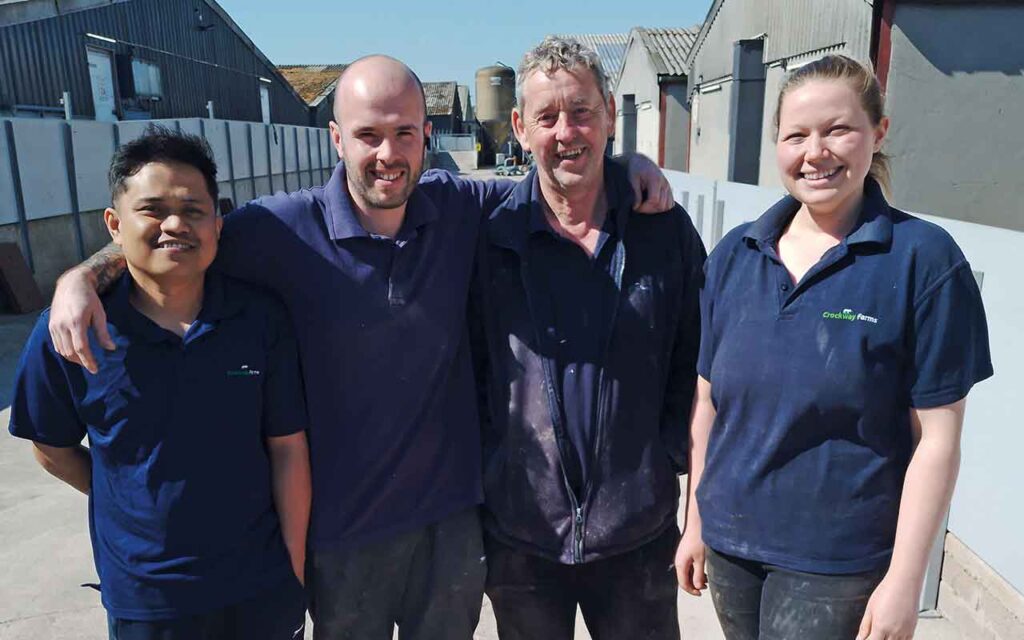The team at Crockway Farms, in Dorset, is strikingly efficient and focused, with a welcoming family atmosphere – a winning combination that earned them the Indoor and Overall Producer of the Year titles at the 2024 National Pig Awards.
Attention to detail in every aspect of stockpersonship and motivation among the unit’s 17 staff members is central to maintaining the health, welfare and performance of pigs, which are kept in a range of refurbished and new fully slatted accommodation.
Results are outstanding – the herd is averaging 36.2 pigs weaned/sow/year, after a performance dip linked to an enzootic pneumonia (EP) outbreak, but the team are on track to return to their previous 38 pigs/sow/year, after really positive strides in the past few months.
Farm manager Martin Atkin said their primary aims are to focus on the welfare of the pigs, to be the top-performing unit in the country and the best of all JMW Farms’ units in England and Ireland.
Pigs have been kept at Crockway Farms since the 1970s and it has been under the ownership of JMW Farms since 2007, currently housing 22,000 pigs on site, with gilts, sows and growing piglets.
It is a continuous system, producing around 2,500 pigs a week, which go to separate finisher units at about 37kg.
A contractor rents the 250 acres of arable land at Crockway Farms and receives all the pig unit’s slurry in return for spreading it on their own ground and other farms.
Heat for the whole unit is generated by a biomass boiler, while solar panels on two of the buildings also help to minimise emissions and energy costs.
People are a priority
The herd’s success is all about getting the right people to work in the team, said Martin.
“People need to be able to fit in and work with the rest of the team, and it has taken a long time to find the team we have now, who all want to be here and do the best job they can.”
Martin is very open in job interviews about what the role entails and Clementine Milton, head of farrowing and the 2024 Young Pig Farmer of the Year, joins him to help provide potential new team members with all the information they need.
The farrowing team is made up of eight people, with four others in the dry sow department and three looking after the weaners, plus an additional ‘floating’ team member who provides holiday cover for all departments. Staff work a 10-hour day, five days a week and work one weekend in three on a rota.
Clementine organises team evenings out – for example, to the bowling alley – to help create time for people to relax, especially in the winter when mood and morale can often dip. Many of the team now have accommodation at the farm, which makes it easy to socialise.
“Everyone gets on well and we chat or have barbecues in the garden in the evenings or on bank holidays. Or we might go out for breakfast together,” said Clementine. “We also go to regional NPA meetings as a team.”
The camaraderie continues throughout the working day, with plenty of light-hearted banter around the unit.
Cleanliness and tidiness throughout the unit reflects its professionalism and high standards, which include the levels of care for the animals and people.
As well as purpose-built showers for all staff and visitors, with clear ‘clean’ and ‘dirty’ sides, they have a light, spacious canteen with modern kitchen facilities, plus a TV that can also be used for staff training. The friendly atmosphere and good working environment contribute to staff motivation.



New employees have an induction period, which includes formal training, covering health and safety, for example, which is standardised across JMW Farms, and on-the-job training.
The first day is spent on orientation, getting to know where everything is, and a ‘buddy system’ ensures that new team members have another member of staff with them throughout the working day to begin with while they learn tasks and routines.
It is important for each person to understand how every area of the farm works and the impact of one department on the next – it also means they can provide cover when needed.
“We all muck in and do all the jobs, myself included, however basic,” said Clementine.
“We constantly check in, encourage people, re-explain or ask what we can do to help if someone is struggling, whether with their work or personally – I would say checking in with the team is my main role.”
Jim and Andrew, part of JMW’s management team, are also very supportive of all staff, whether remotely or during visits, while giving Martin and his staff autonomy to run the unit.
Health and data
The herd has a good health status, and the team do everything they can to keep disease from entering, ranging from the showering facilities to clear signage and disinfectant at the entrance and CCTV (see p40 for more on its approach to biosecurity).
Health planning is led by JMW Farms’ in-house vet, Michael Hamill, a former Young Farm Vet of the Year, working with the team on farm, while Adrian Cox of Farmvet carries out quarterly visits.
Gilts and sows are vaccinated against porcine circovirus type 2, E coli and rotavirus, and they have also started vaccinating against EP this year following the recent challenge.
There is a large amount of information to communicate and record, and simple visual systems mean details are seldom missed and staff can make sure each animal receives what it needs.
For example, farrowing pen sow cards are rotated from portrait to landscape to show which sows are being treated, so stockpeople can see this easily.
Purple clothes pegs are also attached to sow cards to show which farrowing pens have piglets to be fostered, with one peg per piglet.
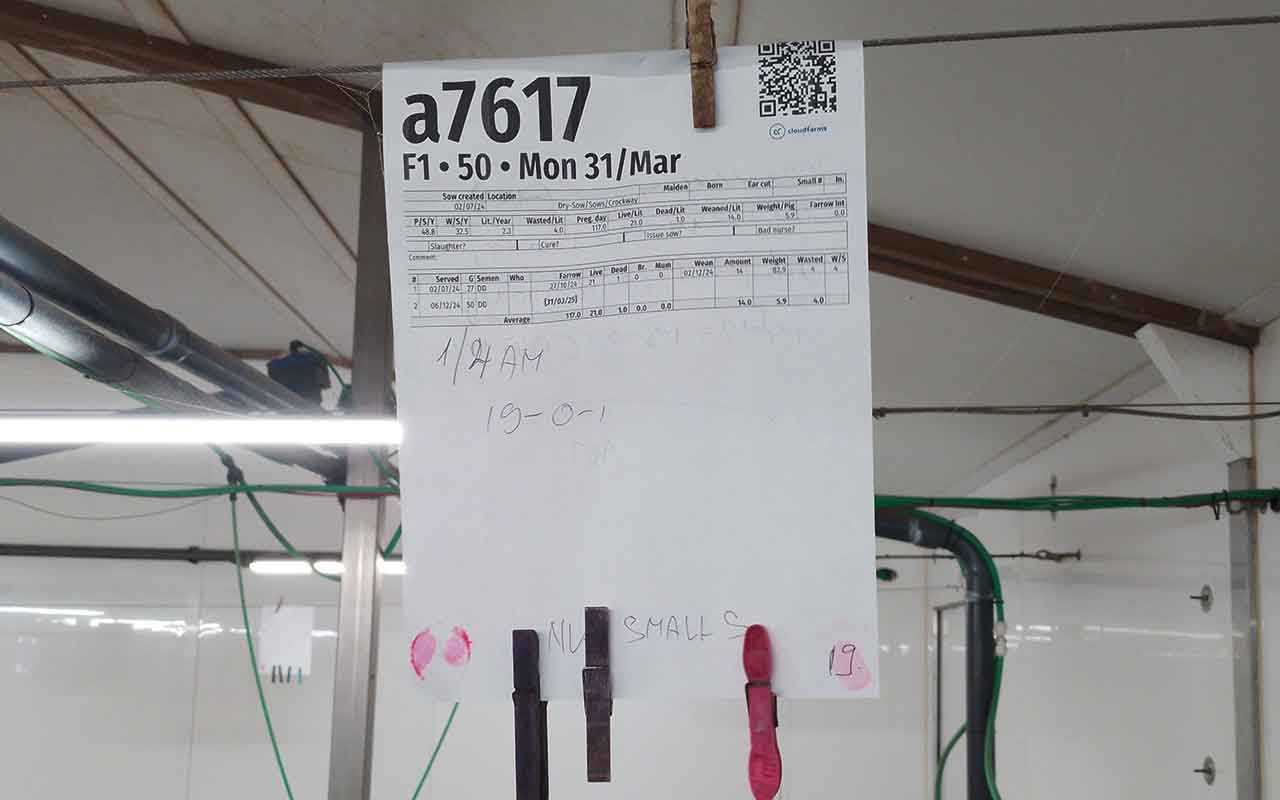
Cloudfarms is used to record and analyse performance data. Clementine uses it to pull out three-monthly parity performance and fertility reports, for example.
The weekly production sheet with key performance data is printed and put in the canteen, and discussed with all team members, so everyone is aware of any dips or boosts in performance and what might have caused them.
Key performance indicators monitored in the farrowing department are numbers born alive, numbers weaned and average weaning weights – which are currently running at about 5.9kg – along with deaths and what caused them.
For dry sows, they focus on conception rates and wasted days. Growth rate, feed conversion ratio and mortality are the key measures for weaners and growers, with growth averaging 670g/day from weaning to 37kg.
“We only record what we really need to monitor,” said Martin. “We need to be actually looking at the pigs as much as possible.”
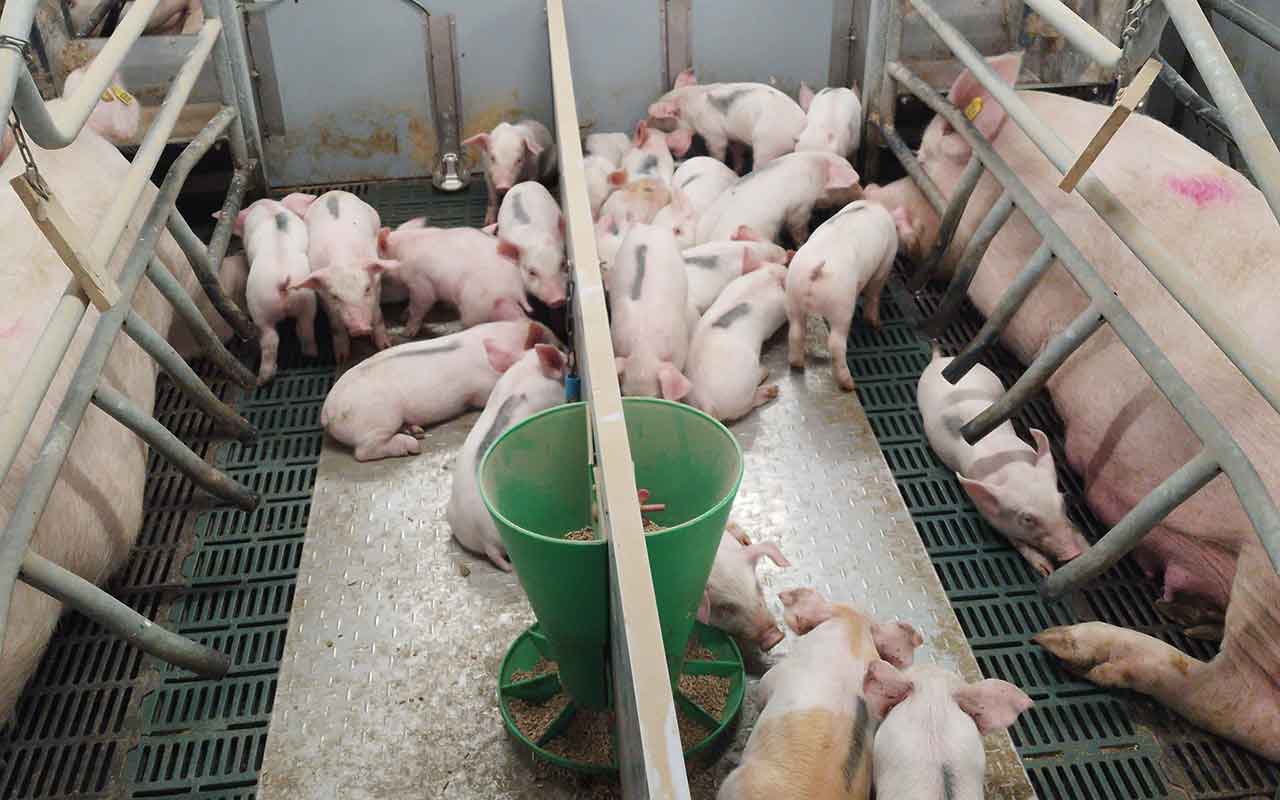
Farrowing and fostering
They have three pairs within the farrowing team, with one pair focused purely on the litters up to seven days after farrowing (the ‘smalls’), another pair on the ‘mids’ (from seven days to 14 days), and the third looking after ‘pre-weaning’ litters in their last couple of weeks.
“The same people stay on either smalls, mids or pre-weaning litters, so they get to know that group of sows really well,” said Clementine.
Fostering is central to litter management on the unit, with an average of 15 born alive per sow .They expect this will soon be back up to the herd’s normal average of 16.2, following improvements to service routine and better health.
The smallest piglets are fostered onto second-parity sows, which provide plenty of colostrum with a lower risk of overlays. They don’t do any split-suckling, as they regularly size the piglets and any smalls can be moved back a week onto a sow suckling a younger litter.
“The aim is to give every pig, including all small pigs, the best shot at survival,” Martin said, adding that when they are the same size as their littermates, piglets can all compete for milk and creep.
Supplementary milk cups provide milk to piglets from four or five days after farrowing, and creep feed is given from five to seven days, topped up twice a day.
As well as preparing piglets for weaning, stockpeople check that sows are in good condition to go back to service, including treating any lameness, making sure all sows get up every day.
Several types of sow enrichment are used in the farrowing pens, including plastic chews, which sows slide along the bars, wood hanging on a chain and paper for nesting. There are also chains and pipe provided for the piglets in the farrowing and nursery departments.
They only see occasional issues with tail biting and find that sizing the pigs in the nursery helps to minimise it. Feeding is also tailored to the size of the piglets in each room, and providing the optimal air temperature is another key factor in welfare and performance.
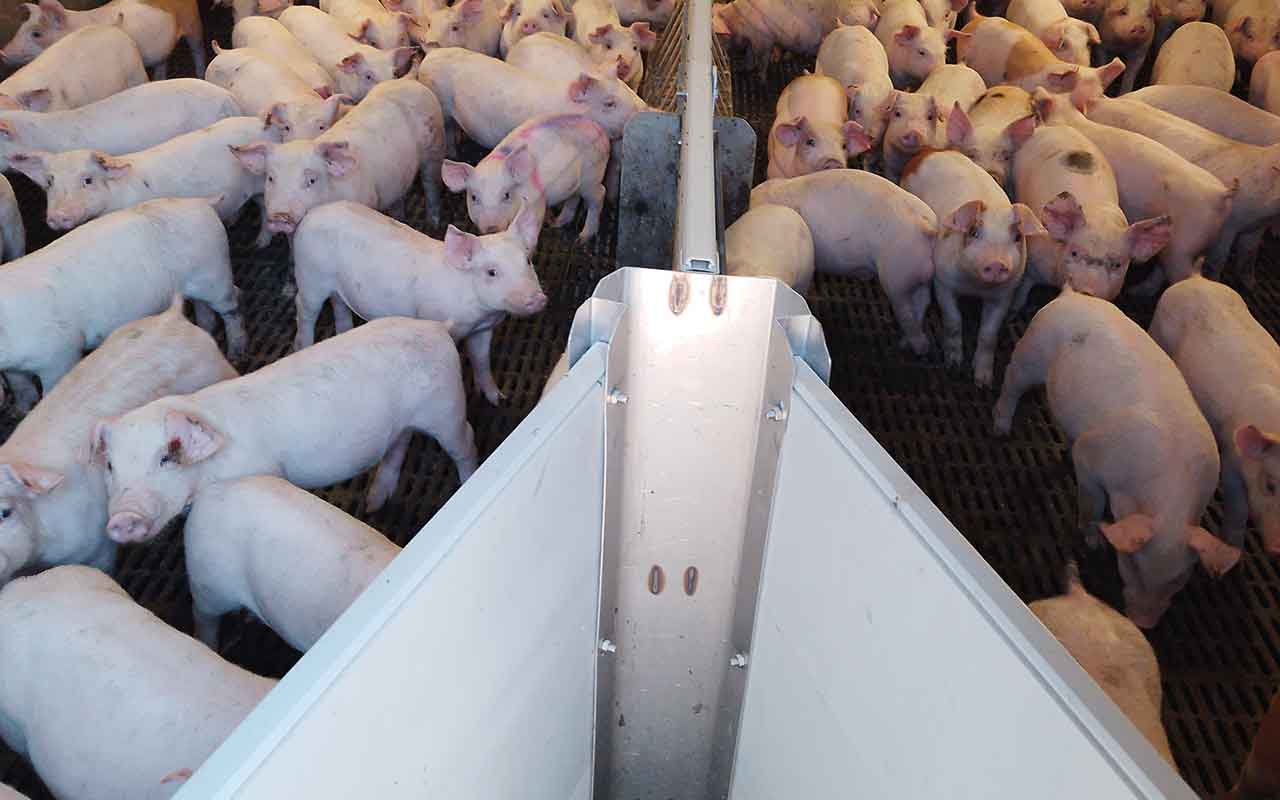
Sow, gilt and service management
The herd is made up of Large White crossed with Landrace genetics, from Klasse AI, with gilts brought in from JMW’s nucleus breeding herd in Ireland. They are grown for four to six weeks at Crockway Farms before Regumate is given and they are served.
Changes to sow nutrition and service routine in the past few months have combined to increase conception rates from 88% to 94%, with sows averaging 17.9 born alive per litter, up from 16.4, and gilts averaging 17.4 born alive, up from 16.2.
A member of staff moved across to a new role in the service team and they took the opportunity to review and adjust the service routine, which has boosted conception rates and numbers born alive.
The time of day sows were served was not always consistent in the past, but it is now done at the same time every morning, with gilts served at 6-8.30am, and sows from 9am onwards.
Animals are served twice, sometimes three times if they are on heat, with boars running up and down the passageways next to the service area to aid heat detection.
Green plastic hoops are used to hold up the artificial insemination bag during service and, once complete, staff do not go in for the rest of the day so sows can relax.
All sows are wet-fed with diets of wheat and barley, soya, water and some sugar beet. All sow diets are milled on site with a mobile mixer and there are plans to put up a new building to enable them to mill and mix their own creep and link diets as well, which are currently brought over from JMW’s facilities in Ireland.
Grain goes through macerators, reducing it to a fine grist size, to help increase both sow feed intake and their nutritional uptake. The £4,000 investment was paid for in one year, Martin said.
Specific service diet
An important recent change has been to introduce a specific service diet in between the lactation and dry sow diets, which has helped improve fertility and conception rates, alongside changes to service routine.
Martin asked their nutritionist, Cargill’s Maisie Lord, to formulate the service ration, which is fed for a two-week period starting as soon as sows enter the service area, where they are fed twice a day in free-access crates.
Martin also hopes the service diet will help increase the number of piglets born alive a bit further. Sows are given seven days after service before moving into the dry sow sheds, so they are more settled and have a higher body mass. Dry sows are grouped by size and fed once a day.
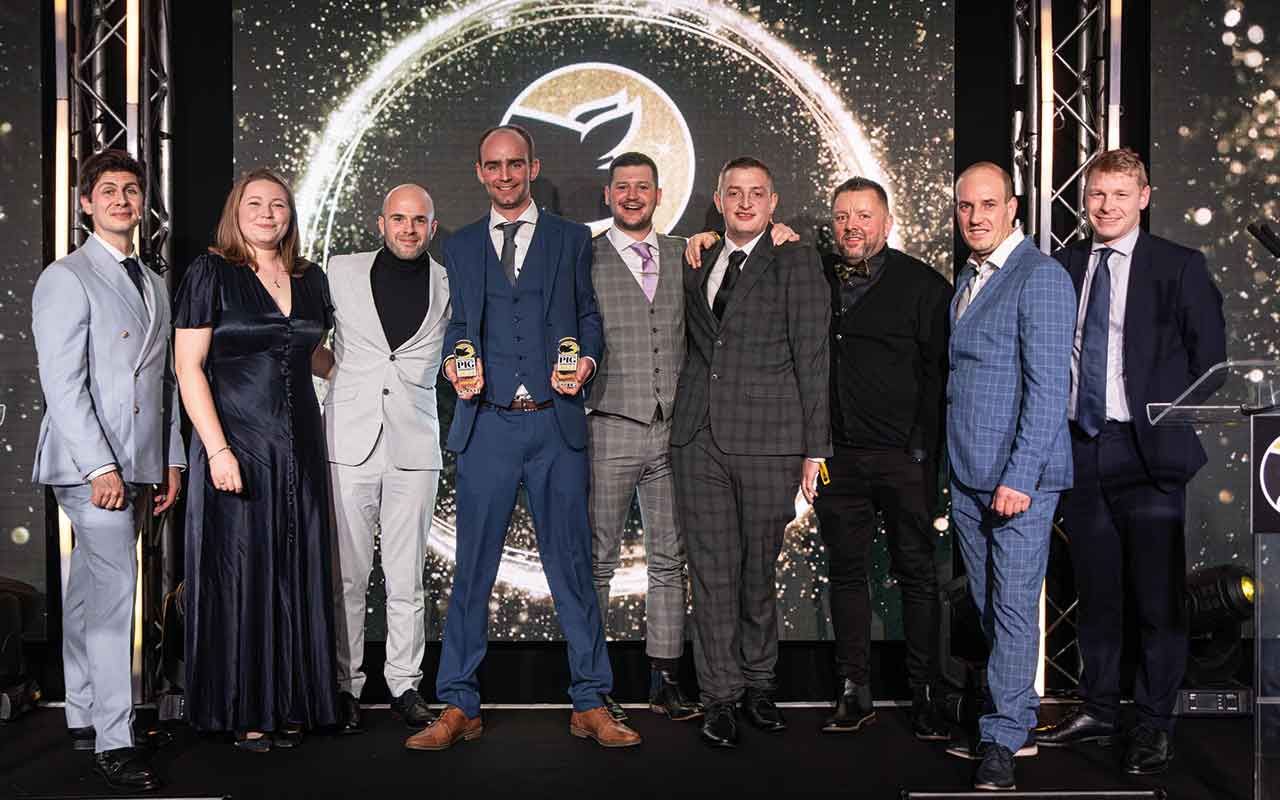
Another factor that has helped improve conception rates is adding a sugar topdressing to gilt feed. “Gentle handling is also really important,” said Martin.
“We encourage staff to interact with gilts and they are in the pens with them a lot, adding the topdressing and giving Regumate, to help get them used to people.”
The team were delighted to win the award, and their unity and the passion they feel for what they do was evident for all to see on the night. The focus on the wellbeing and the interaction between pigs and people will, no doubt, continue to be at the heart of this unit’s success.




